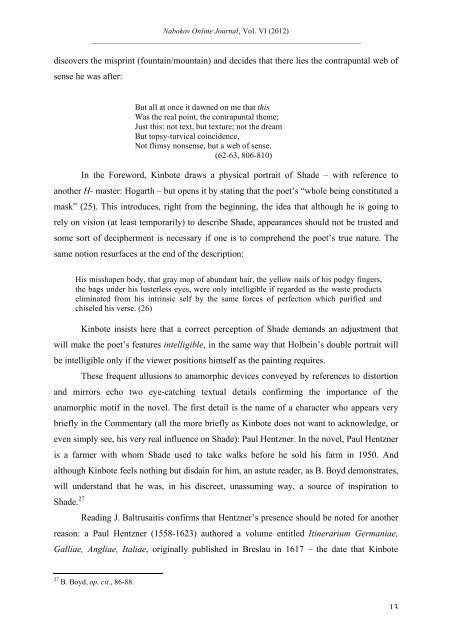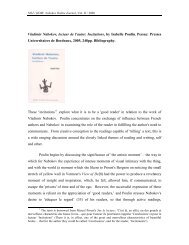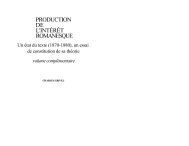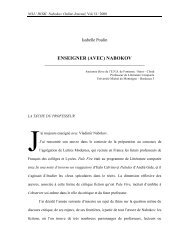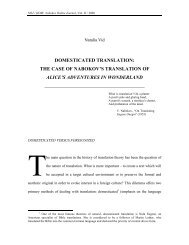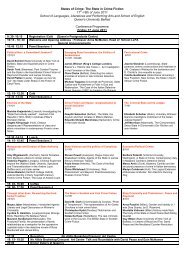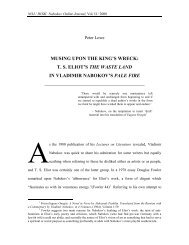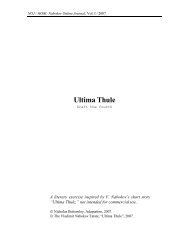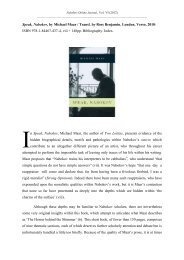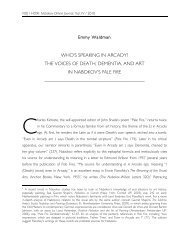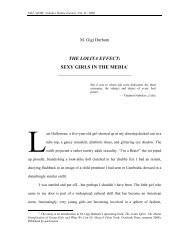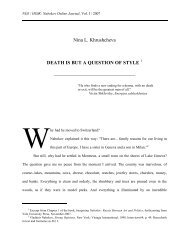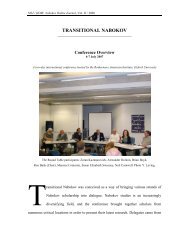through the looking-glass – pale fire as anamorphosis
through the looking-glass – pale fire as anamorphosis
through the looking-glass – pale fire as anamorphosis
You also want an ePaper? Increase the reach of your titles
YUMPU automatically turns print PDFs into web optimized ePapers that Google loves.
Nabokov Online Journal, Vol. VI (2012)<br />
_______________________________________________________________________<br />
discovers <strong>the</strong> misprint (fountain/mountain) and decides that <strong>the</strong>re lies <strong>the</strong> contrapuntal web of<br />
sense he w<strong>as</strong> after:<br />
But all at once it dawned on me that this<br />
W<strong>as</strong> <strong>the</strong> real point, <strong>the</strong> contrapuntal <strong>the</strong>me;<br />
Just this: not text, but texture; not <strong>the</strong> dream<br />
But topsy-turvical coincidence,<br />
Not flimsy nonsense, but a web of sense.<br />
(62-63, 806-810)<br />
In <strong>the</strong> Foreword, Kinbote draws a physical portrait of Shade <strong>–</strong> with reference to<br />
ano<strong>the</strong>r H- m<strong>as</strong>ter: Hogarth <strong>–</strong> but opens it by stating that <strong>the</strong> poet’s “whole being constituted a<br />
m<strong>as</strong>k” (25). This introduces, right from <strong>the</strong> beginning, <strong>the</strong> idea that although he is going to<br />
rely on vision (at le<strong>as</strong>t temporarily) to describe Shade, appearances should not be trusted and<br />
some sort of decipherment is necessary if one is to comprehend <strong>the</strong> poet’s true nature. The<br />
same notion resurfaces at <strong>the</strong> end of <strong>the</strong> description:<br />
His misshapen body, that gray mop of abundant hair, <strong>the</strong> yellow nails of his pudgy fingers,<br />
<strong>the</strong> bags under his lusterless eyes, were only intelligible if regarded <strong>as</strong> <strong>the</strong> w<strong>as</strong>te products<br />
eliminated from his intrinsic self by <strong>the</strong> same forces of perfection which purified and<br />
chiseled his verse. (26)<br />
Kinbote insists here that a correct perception of Shade demands an adjustment that<br />
will make <strong>the</strong> poet’s features intelligible, in <strong>the</strong> same way that Holbein’s double portrait will<br />
be intelligible only if <strong>the</strong> viewer positions himself <strong>as</strong> <strong>the</strong> painting requires.<br />
These frequent allusions to anamorphic devices conveyed by references to distortion<br />
and mirrors echo two eye-catching textual details confirming <strong>the</strong> importance of <strong>the</strong><br />
anamorphic motif in <strong>the</strong> novel. The first detail is <strong>the</strong> name of a character who appears very<br />
briefly in <strong>the</strong> Commentary (all <strong>the</strong> more briefly <strong>as</strong> Kinbote does not want to acknowledge, or<br />
even simply see, his very real influence on Shade): Paul Hentzner. In <strong>the</strong> novel, Paul Hentzner<br />
is a farmer with whom Shade used to take walks before he sold his farm in 1950. And<br />
although Kinbote feels nothing but disdain for him, an <strong>as</strong>tute reader, <strong>as</strong> B. Boyd demonstrates,<br />
will understand that he w<strong>as</strong>, in his discreet, un<strong>as</strong>suming way, a source of inspiration to<br />
Shade. 27<br />
Reading J. Baltrusaitis confirms that Hentzner’s presence should be noted for ano<strong>the</strong>r<br />
re<strong>as</strong>on: a Paul Hentzner (1558-1623) authored a volume entitled Itinerarium Germaniae,<br />
Galliae, Angliae, Italiae, originally published in Breslau in 1617 <strong>–</strong> <strong>the</strong> date that Kinbote<br />
27 B. Boyd, op. cit., 86-88.<br />
13


